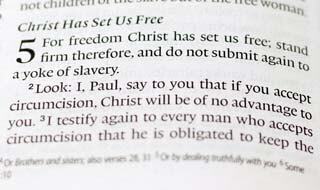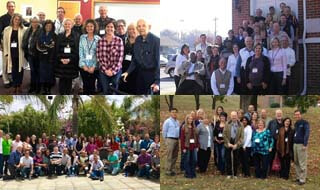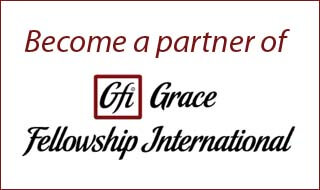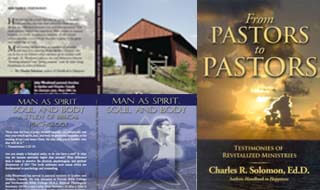
Since we are beginning a new year, you may have made a “new year’s resolution” to read through the Scriptures this year. That’s a good goal, yet it’s not uncommon to start reading in Genesis, but lose momentum in… Leviticus.
Someone wrote to me: “This week, you talked about being hungry for the Word… However, we have a question about making this hunger a regular part of our lives. We find that it’s easy to begin and really search the Scriptures for a few days, but then things happen–tiredness, or events–and the hunger seems to dissipate. Do you have some suggestions that would help us to remain disciplined over the long run? We would appreciate any help you can give us.” Great question!
First, let’s review some basics. Why is Bible reading so important?
1. Bible reading nourishes your spiritual growth.
The apostle Peter advised, “As newborn babes, desire the pure milk of the word, that you may grow thereby (1 Peter 2:2; Cf. Hebrews 5:12-14). And Christ affirmed, “It is written, ‘Man shall not live by bread alone, but by every word that proceeds from the mouth of God'” (Matthew 4:4; Deuteronomy 8:3).
2. Bible reading increases your discernment.
There are so many denominations, radio teachers, TV preachers, authors–how can you know which ones are reliable? In these last days false teachers abound. Paul warned Timothy, “… the time will come when they will not endure sound doctrine, but according to their own desires, because they have itching ears, they will heap up for themselves teachers; and they will turn their ears away from the truth, and be turned aside to fables. But you be watchful in all things…” (2 Timothy 4:2-5).
3. Bible reading equips you for Christian living. “All Scripture is given by inspiration of God, and is profitable for doctrine, for reproof, for correction, for instruction in righteousness, that the man of God may be complete, thoroughly equipped for every good work” (2 Timothy 3:16,17).
A plan that has proven invaluable to me since 1974 has been what I call “the Balanced Diet Reading Plan.”[1] It was suggested by one of my Bible college teachers. Simply put, I have bookmarks in my Bible that correspond to the sections of the Bible’s literature.
You can try a two bookmark plan (Old and New Testament) or more. The principle is to read the whole Bible for your whole life.
I like a five bookmark plan: Old Testament law and history (Genesis-Esther); Old Testament poetry (Job-Song Of Solomon); Old Testament prophets (Isaiah-Malachi); New Testament history (Matthew-Acts); New Testament letters (Romans-Revelation).[2]
The plan calls for continually reading through these sections at your own pace. When you get to the end of a section, the bookmark for that section goes back to the beginning of that section. For example, in the five bookmark option, when you finish Acts, that bookmark goes back to Matthew, chapter 1; when you finish Revelation, that bookmark returns to Romans ch. 1, etc. As one hungry for spiritual food, continue reading (ideally, each day) in each of your bookmark sections. In the New Testament read portions rather than primarily chapters, (By “portion” I mean a sub-heading in the English Bible, e.g., Christ’s birth in Matt 1:18-25). This helps you savor the topic of the portion(s).
This plan is flexible. I typically enjoy Old Testament poetry, New Testament history, and New Testament letters daily while the other two Old Testament “bookmarks” are waiting for me as time and opportunity permit.[3]
Imagine eating one kind of food for every meal, day after day. Your taste for it would probably diminish. Why? Because God designed us to appreciate variety. In God’s Word we have a sacred library of 66 books written by about 40 different human authors–variety! Yet all aspects of God’s Word are part of an organic whole, given the Holy Spirit. As Peter wrote, “And so we have the prophetic word confirmed, which you do well to heed as a light that shines in a dark place, until the day dawns and the morning star rises in your hearts; knowing this first, that no prophecy of Scripture is of any private interpretation, for prophecy never came by the will of man, but holy men of God spoke as they were moved by the Holy Spirit” (2 Peter 1:19-21).
Without a Bible reading plan, we usually fall back to random choice which makes us more susceptible to neglecting Scripture. Also, without a comprehensive reading strategy, one is likely to miss the whole counsel of God (Acts 5:20; 20:27). Since the Holy Spirit gave us God’s Word book by book, reading it this way respects its context.
Many find a Bible handbook useful in understanding Scripture. This reference tool contains background information on each Biblical book: the human authors, historical setting, geography, culture, chronology, purpose, outline, and a brief commentary.[4] Or you try out a study Bible, which contains much of this material in one volume with the Biblical text. Knowing the introductory information about the books really helps in comprehending the Scripture’s meaning and flow of thought.[5]
Now, some readers who emphasize grace bristle at the thought of external guidelines, methods, or disciplines. How does the New Testament answer this? Timothy was counseled, “If you instruct the brethren in these things, you will be a good minister of Jesus Christ, nourished in the words of faith and of the good doctrine which you have carefully followed… exercise yourself toward godliness” (1 Timothy 4:6,7). Although spiritual disciplines should not be handled legalistically, they contribute to abundant living. Such aspects of discipleship need to be empowered by Christ in us and motivated by loving gratitude to God. The Lord Jesus modeled the Spirit-filled life and practiced spiritual disciplines. Christ knew and used the Holy Scripture throughout His ministry and made time to pray (Luke 4:21; Mark 1:35-38;6:46).
This Bible reading method is further enriched by combining it with prayer. Like a swimming pool’s diving board, the Bible reading can “spring” you toward intercession. By itself, prayer can become repetitive and formal. However, when connected with personal Bible reading, prayer is fresh each day. There are promises to claim, sins to confess, examples to follow, lessons to learn, principles to apply, and God’s attributes to worship. This variety in prayer also prevents the Bible reading from being merely academic.[6]
If you read the Bible this way for a few weeks, you will see how the Scripture interrelates in some wonderful ways. “The Old Testament is the New Testament concealed; the New Testament is the Old Testament revealed.”
You’re invited to experiment with the “Balanced Diet Reading Plan”. Just dig in and adapt it to your needs and schedule. If this method is a blessing to you, pass it on. Bon appetit!
Notes:
[1] Dr. Mark Cambron of Florida Bible College mentioned his daily Bible study method, based on different literary sections of Scripture.
[2] Technically, The first O. T. section is comprised of Law (Genesis-Deuteronomy) and history (Joshua-Esther). In the five bookmark plan I combine them. There is much narrative in the Law section and I prefer to have a higher ratio N.T. reading.
Revelation contains letters (epistles) in chapters 2-3. Although it is distinct as apocalyptic literature, I combine it with part 2 (epistles) of the N.T.
[3] Notice that there is flexibility. The value of the plan is to systematically read the whole Bible for your whole life. Shift the pace or group the sections differently as you are led. You can opt for a two, three, four or five bookmark section plan to suit your preferences.
Perhaps you appreciate the idea of this plan, but you’d like a “balanced diet” that is already formatted. Try pre-sliced bread (real title: The One Year Bible) which reorganizes the Bible into daily sections of O.T., N.T., and Psalms-Proverbs.
[4] Ungers’, Halleys’, Eerdmans’ are popular handbooks. Like a Swiss Army knife, a Bible Handbook has many tools in one volume.
[5] Nelson Study Bible (my favorite), NIV Study Bible, Thompson Chain Reference, et. al. (Just remember, however, that God’s Word alone is infallible, not the study notes.)
[6] A book focused on this approach is Beth Moore’s “Praying God’s Word: Breaking Free From Spiritual Strongholds” (Broadman & Holman).
Historical note: The followers of Wesley and Whitefield in 18th century England emphasized methodical spiritual disciplines. Churches that sprang from John and Charles Wesley’s ministry became known as “Methodists.”
Here’s a craft idea: Cut a piece of card stock paper 1″ x 3″. Cut several colored ribbons in 12″ lengths (a color for every bookmark you will need for your 2, 3, 4, or 5 area reading plan). Lay the end of the ribbons on the rectangle card stock (that is narrow enough to fit in the spine of the Bible). Then take a piece of duct tape and wrap it around the card and ribbons to secure them in place. Now slide the taped card behind your Bible’s spine, between the binding and the cover. The ribbons can now be brought over to be used as bookmarks for your Balanced Diet Reading Plan.
Copyright 2002, 2014 by John Woodward. 3rd edition. Permission is granted to reprint for non-commercial use. Biblical quotations are from the New King James version, copyright by Thomas Nelson.

















